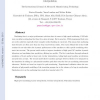Free Online Productivity Tools
i2Speak
i2Symbol
i2OCR
iTex2Img
iWeb2Print
iWeb2Shot
i2Type
iPdf2Split
iPdf2Merge
i2Bopomofo
i2Arabic
i2Style
i2Image
i2PDF
iLatex2Rtf
Sci2ools
CORR
2010
Springer
2010
Springer
Kinematic modelling of a 3-axis NC machine tool in linear and circular interpolation
Machining time is a major performance criterion when it comes to high speed machining. CAM software can help in estimating that time for a given strategy. But in practice, CAM programmed feed rates are rarely achieved, especially where complex surface finishing is concerned. This means that machining time forecasts are often more than one step removed from reality. The reason behind this is that CAM routines do not take either the dynamic performances of the machines or their specific machining tolerances into account. The present article seeks to improve simulation of high speed NC machine dynamic behaviour and machining time prediction, offering two models. The first contributes through enhanced simulation of 3-axis paths in linear and circular interpolation, taking high speed machine accelerations and jerks into account. The second model allows transition passages between blocks to be integrated in the simulation by adding in a polynomial transition path that caters for the true ma...
| Added | 09 Dec 2010 |
| Updated | 09 Dec 2010 |
| Type | Journal |
| Year | 2010 |
| Where | CORR |
| Authors | Xavier Pessoles, Yann Landon, Walter Rubio |
Comments (0)

